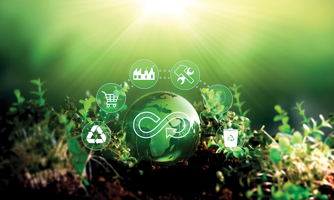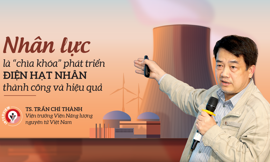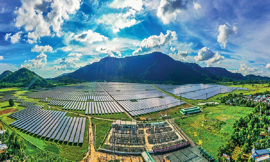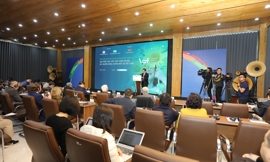The circular economy model in agriculture promotes a closed-loop production
system that maximizes the use of resources and recycles by-products. Such an approach
not only helps reduce costs but also boosts productivity, improves product quality,
and contributes to environmental protection. Adopting a circular economy has
become a necessary path to boost competitiveness and create sustainable added value
for Vietnamese agriculture.
Barriers to circular agriculture
At the “Promoting a Circular Economy in Agriculture” forum, organized by the
Vietnam Chamber of Commerce and Industry (VCCI), Mr. Ha Van Thang, Chairman of the
Vietnam Circular Agriculture Corporate Council (VCAC) and Chairman of the Board
at the T&T 159 JSC, said a number of businesses and farming households across
various localities have proactively adopted circular economy models in their production
processes over recent years. These practices have helped cut input costs while increasing
the value of outputs by producing safer, more environmentally-friendly products.
However, the adoption of circular economy principles in agriculture still faces
numerous barriers and challenges. There is, for example, a lack of clear mechanisms
and incentive policies, with no specific policy framework introduced to support
circular agricultural models. Many production practices are still subject to outdated
regulations that no longer reflect current realities.
Access to capital and technology remains a major hurdle, especially for small
and medium-sized enterprises (SMEs), which often lack the financial capacity to
invest in recycling and waste treatment technologies. In addition, there is limited
regional integration and weak value chain links. Many cooperative models remain
ineffective, and businesses often operate in isolation, with little in the way
of collaboration with farmers or other stakeholders.
Another key barrier is the persistence of linear production mindsets. Many
farmers still prioritize short-term profits, relying heavily on chemical inputs
such as fertilizers, pesticides, herbicides, and growth stimulants to maximize yields
at any cost, often at the expense of environmental sustainability. In contrast,
circular production requires systems thinking, long-term investment, and a fundamental
shift in production management approaches.
Furthermore, the workforce of researchers and technical experts in waste treatment
and by-product processing in agriculture is still limited, partly due to the absence
of supportive policies for this particular cohort. The application of scientific
and technological solutions, including digital innovations, also encounters obstacles
due to rigid existing regulations. In other words, we are still using outdated regulatory
tools to manage new models, solutions, and approaches.
According to Mr. Thang, innovation must be understood as replacing outdated
and ineffective methods with newer, more efficient, and safer solutions. Yet many
of these “new approaches” are not recognized by current legal frameworks, inadvertently
creating barriers to innovation and discouraging the bold application of circular
agriculture models.
Mr. Nguyen Tri Ngoc, Vice Chairman and Secretary-General of the Vietnam General
Association of Agriculture and Rural Development, emphasized that many current legal
regulations are still too general and not well-tailored to the specific characteristics
of circular production models. Moreover, governance practices remain rooted in linear
production thinking, while modern models require more flexibility and openness.
Besides policy constraints, Mr. Ngoc also highlighted significant financial
challenges. Most agricultural businesses in Vietnam are SMEs or farming households,
with accessing investment capital, especially green finance, remaining a major hurdle.
Meanwhile, circular production demands considerable and long-term investment, including
waste treatment, recycling, and the development of bio-based products.
Empowering farmers and SMEs
To make the circular economy a mainstream direction in agriculture, Mr. Thang
emphasized the urgent need to build a well-aligned policy ecosystem. This should
include mechanisms for green finance and credit support, tax and land-use incentives
for businesses investing in clean and circular production, infrastructure development
for concentrated farming zones, updated standards and traceability systems, workforce
training programs, and stronger market links.
He also highlighted the need for flexible trial mechanisms that encourage innovation
at the household production level, following the principle of “register first, inspect
later”. Under this approach, circular initiatives could be piloted within a set
timeframe without being immediately bound by rigid administrative rules. This would
give room for bold experimentation with new production methods.
Mr. Thang further emphasized the important role of agricultural extension programs
in transferring circular production technologies, particularly in recycling by-products
from the rice industry such as straw, husks, and bran. These materials can be turned
into organic fertilizers, animal feed, mushroom growing media, or bio-bedding. He
stressed that technical standards should be easy to understand and practical to
apply, enabling farmers to participate actively and meaningfully.
The circular economy is no longer an option; it has become a necessity to improve
competitiveness and create long-term value for Vietnamese agriculture. To achieve
this, Mr. Thang called for close cooperation between the government, businesses,
farmers, scientists, and investors. Among these, farmers, as those directly involved
in production, will play a decisive role in building a modern and green agricultural
system rooted in circular principles.
Mr. Ngoc added that any system of technical standards must be grounded in actual
production practices. Local authorities should have the flexibility to access scientific
and technological resources and build pilot models that reflect actual conditions.
These models could help form the foundation for future national standards and broader
adoption. He also called for targeted credit policies to support businesses genuinely
committed to advancing the circular economy.
During the discussion, Ms. Nguyen Thi Thu Trang, Director of the GreenU Supporting
Green Development Social Enterprise at CIRCO Hub Vietnam, highlighted the importance
of embedding circular design thinking and business models from the very beginning,
especially for agricultural SMEs. This mindset allows businesses to uncover new
value creation opportunities based on regeneration and resource optimization. Circular
thinking goes beyond material reuse and product life extension; it touches every
part of the production ecosystem, from packaging design to supply chain strategy.
Integrating circular design helps businesses align with sustainable consumption
trends while building a resilient foundation for long-term growth in a rapidly-evolving
market landscape with increasingly strict environmental standards. According to
Ms. Trang, this is a prime opportunity for SMEs to both reduce costs and create
high-value products that can meet the expectations of demanding markets such as
the EU and US.
On the topic of workforce development for circular agriculture, Dr. Vu Duy
Hoang, Acting Director of the Center for Organic Agriculture Promotion and Studies
(COAPS) at the Vietnam National University of Agriculture, underscored the need
to train a new generation of experts equipped with thorough knowledge, applied skills,
and a passion for innovation. He also stressed the importance of developing simplified
learning materials on circular agricultural practices, making it easier for farmers
to understand and adopt them effectively.












![[Interactive]: Toàn cảnh kinh tế Việt Nam tháng 8/2025](https://premedia.vneconomy.vn/files/uploads/2025/09/06/313418e027db4b97adaba4c542e2f904-10696.png?w=700&h=420&mode=crop)

